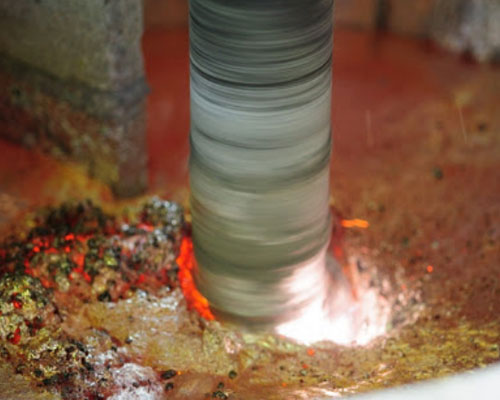The internal quality defects of aluminum rods mainly include pores and slag inclusions. Whether it is pores or slag inclusions, they can reduce the tensile strength and elongation of electrical round aluminum rods, increase their resistivity, and affect the normality of electrical round aluminum rods.
Internal defects of aluminum rods have a great influence on the performance of electrical round aluminum. When casting, the content of pores in the cast slab is high, which may cause wire breakage during re-rolling or breakage during winding.
Internal Defects of Aluminum Rods
Main Causes of Stomata
1) The temperature of the molten aluminum is too high, resulting in too high gas content. According to experiments, the gas content in the molten aluminum is directly proportional to the temperature.
2) During the casting process, the large amount of steam produced by the cooling water was not dispersed in time, and part of the steam was dissolved into the aluminum liquid to form pores.
3) There is too little lubricating oil on the steel strip to form a better protective oil film, causing steam to enter the molten aluminum.
Main Measures
1) Reduce the temperature of the molten aluminum to ensure that the temperature of the molten aluminum is within the normal casting temperature range.
2) Install a degassing unit before casting, such as online degassing with high-purity nitrogen or nitrogen-chlorine mixed gas or degassing and slagging in the mixing furnace.
3) Install a fan at the casting part to blow the steam away.
4) During the casting process, adjust the amount of lubricating oil to ensure that there is a protective oil film on the steel belt.
Internal slag inclusions also have a great impact on the performance of the electrical round aluminum alloy, which may cause wire breakage or billet breakage during the production process.

Main Influencing Factors of Slag Inclusion
1) There is too much slag inside the aluminum liquid, and no effective refining treatment is carried out.
2) The temperature of the molten aluminum is too high, resulting in more oxidation scum.
3) During the transfer process of the molten aluminum in the casting launder, no ladle shroud and floats are used, so that the molten aluminum is constantly washed, causing the slag to dissolve into the molten aluminum.
Main Measures
1) Refine the molten aluminum in the mixing furnace, such as adding refining agents, slagging agents, etc. to ensure the standing time of the molten aluminum.
2) Do a good job in the temperature control of the mixing furnace to ensure that the temperature of the molten aluminum is within the standard range.
3) Add a filter device before casting, such as using a ceramic foam filter for filtration.
4) During the transfer process of the trough and launder, the ladle shroud and float plate are used to make the molten aluminum flow in the lower layer of the oxide film, keep the liquid level stable, and avoid washing the oxide slag into the molten aluminum.

